 W
WThe Awaji Yumebutai (淡路夢舞台) is a complex of conference center, hotel and memorial in Awaji, Hyōgo, built near the epicenter of the 1995 Great Hanshin Awaji earthquake. It was designed by Tadao Ando, who had begun planning for the project prior to the earthquake. The hotel is operated as the Westin Awaji Island Resort.
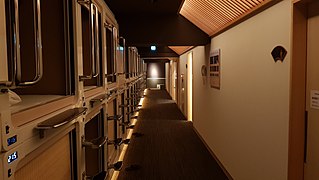 W
WCapsule hotel, also known in the Western world as a pod hotel, is a type of hotel developed in Japan that features many small bed-sized rooms known as capsules. Capsule hotels provide cheap, basic overnight accommodation for guests who do not require or who cannot afford larger, more expensive rooms offered by more conventional hotels.
 W
WThe Chigasakikan (茅ヶ崎館) is a ryokan located in Chigasaki, Kanagawa, Japan.
 W
WChigira Jinsentei is the oldest ryokan in Ikaho, the part of Shibukawa city, Gunma Prefecture.
 W
WThe Fujiya Hotel (富士屋ホテル) is a historic hotel in Miyanoshita in Hakone, Kanagawa, Japan.
 W
WGeto Onsen is a traditional ryokan with "onsen" - natural hot spring baths. It was founded in 1134 and is located in Kitakami, Iwate Prefecture, Japan.
 W
WThe Grand Prince Hotel Takanawa (グランドプリンスホテル高輪) is a complex of three hotels designed by architect Togo Murano in 1982, and situated in the Takanawa district of Minato, Tokyo, Japan. The hotel was originally established as the Takanawa Prince Hotel in 1953.
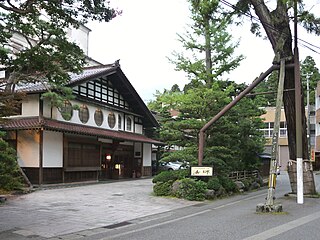 W
WHōshi (法師) is a ryokan founded in 718 in Ishikawa Prefecture, Japan. It has been owned and managed by the Hoshi family for forty-six generations and was thought to be the oldest operating hotel in the world until Nishiyama Onsen Keiunkan, founded in 705, claimed that title.
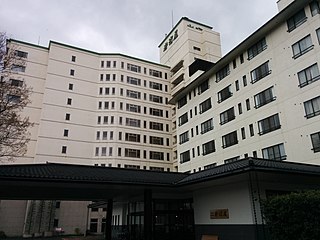 W
WIwanumaya Hotel (岩沼屋) is a hot spring ryokan located in Akiu Onsen, Taihaku Ward, Sendai City, Miyagi Prefecture.
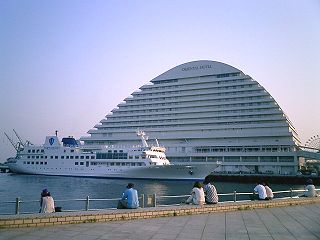 W
WKobe Meriken Park Oriental Hotel is a hotel located close to Meriken Park, in Kobe, Japan. It was opened in June, 1995, only 6 months after the Great Hanshin earthquake destroyed much of the city. It is in the Kobe waterfront area called Harborland, and is often featured in pictures of Kobe, together with Kobe Port Tower. It was designed by Takenaka Corporation to resemble a luxury liner.Rooms: 331 Floors: 14 Ratings: AAA
 W
WSennen-no Yu Koman is a traditional Japanese inn (ryokan) in Kinosaki, Hyōgo Onsen, Toyooka city, Hyōgo prefecture, Japan.
 W
WThe Kōshien Hotel was a Mayan Revival-style hotel in Nishinomiya, Hyōgo, Japan, constructed by Arata Endo, a disciple of Frank Lloyd Wright. It is now used as a hall forming part of Mukogawa Women's University, and is known as the Kōshien Kaikan (甲子園会館).
 W
WA love hotel is a type of short-stay hotel found around the world operated primarily for the purpose of allowing guests privacy for sexual activities. The name originates from "Hotel Love" in Osaka, which was built in 1968 and had a rotating sign. Although love hotels exist all over the world, the term "love hotel" is often used to refer specifically to those located within Japan.
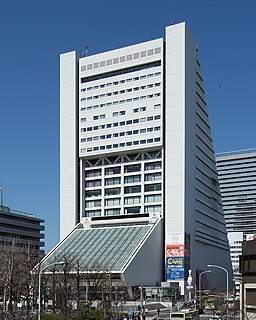 W
WNakano Sunplaza , formerly Nakano Sun Plaza, is a hotel in Nakano, Tokyo. The hotel includes a concert hall, the Nakano Sunplaza Hall. Built in 1973, this concert hall seats 2,222 people. The building is to be demolished and replaced by a new complex including a hotel and a concert hall capable of seating 10,000 people around 2024.
 W
WNara Hotel (奈良ホテル) is a five star hotel in Nara, Japan. The hotel is located on the hillside overlooking Nara Park. Opened on October 17, 1909, it is one of the most historic hotels in Japan. It was designed by Tatsuno Kingo who was also the designer of the Bank of Japan building and the Marunouchi building of Tokyo Station and is known as the teacher of Kenkichi Yabashi, the designer of National Diet Building, and Kataoka Yasushi who was also the designer of Osaka City Hall. It is partially owned by the West Japan Railway Company. In 2009 the first centennial anniversary of the hotel was celebrated.
 W
WNishiyama Onsen Keiunkan (西山温泉慶雲館) is a hot spring hotel in Hayakawa, Yamanashi Prefecture, Japan. Founded in 705 AD by Fujiwara Mahito, it is a long-established business (shinise) as the oldest hotel and perhaps the oldest independent company in operation after Kongō Gumi was acquired in 2006. In 2011, the hotel was recognized by Guinness World Records as the oldest hotel in the world.
 W
WThe Oriental Hotel is a boutique / lifestyle hotel in Kobe, Japan, reopened on March 3, 2010. The hotel is located in the Kōbe kyū-kyoryūchi 25 bankan building at the junction of Kyōmachi-suji Avenue and Nakamachi-dōri Street in the former Kobe foreign settlement. Dating from 1870, it is one of the most historic hotels not only in Japan, but also in Asia.
 W
WA ryokan is a type of traditional Japanese inn that typically features tatami-matted rooms, communal baths, and other public areas where visitors may wear yukata and talk with the owner. Ryokan have existed since the eighth century A.D. during the Keiun period, which is when the oldest hotel in the world, Nishiyama Onsen Keiunkan, was created in 705 A.D. Another old ryokan called Hōshi Ryokan was founded in 718 A.D. and was also known as the world's second oldest hotel. Such inns also served travelers along Japan's highways.
 W
WSakan Ryokan or "Hotel Sakan" (ホテル佐勘) is an historic ryokan located in Sendai, Miyagi Prefecture, Japan. The inn is over 1,000 years old, and is located within the spa resort named "Akiu Spa," which has four communal onsen (baths) that are supplied by natural hot springs. The hot springs are one of the three oldest ones in Japan, and are located near the Natori River. The inn was originally started by a man named Kanzaburo Satoh, whom the inn is named after. Ownership of the inn has been handed down to Satoh's descendants for 34 generations. It is located next to the 400 year old Iwanumaya Hotel.
 W
WThe Sapporo Grand Hotel is an historic hotel in the Chūō district of Sapporo, Japan. It is said to have been constructed at Prince Chichibu's suggestion in 1928, while he was on a skiing trip, that the city needed a western-style hotel. The Grand Hotel first opened its doors in 1934 and was at the time of its construction the tallest building in the city. It benefited considerably from the Japanese Imperial Army's decision to use that part of Hokkaidō for military maneuvers during the 1930s.
 W
WSendai Sun Plaza is a hotel in Miyagino-ku, Sendai, Miyagi Prefecture. The hotel is adjacent to the JR East underground Tsutsujigaoka Station. The twelve-story structure includes a large three-story circular hall with seating for up to 2710 people, which is used as a concert hall and sports venue. It also contains a conference hall, day-care center, wedding facilities and a hotel with 74 rooms. The building was completed in March 1993.
 W
WShima Tamura is a traditional Japanese ryokan founded in 1563 and located near the Shima Onsen in Nakanojō town, Gunma Prefecture.
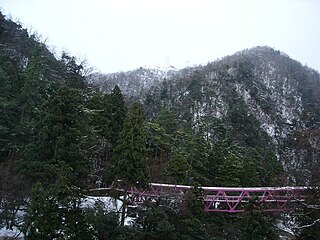 W
WShirasagiyu Tawaraya is a traditional Japanese ryokan (inn) established in 1190, the oldest in Yamanaka Onsen town, part of Kaga city in Ishikawa Prefecture, Japan. The hotel is operated by the same family for over 800 years, now up to the 25th generation.
 W
WShunran-no-Sato are a group of farmhouse inns in Ishikawa Prefecture of Japan, known as some of the first farmhouse inns in Japan. As of 2018, there were 49 inns in total. As a successful case of rural revitalization, they are frequently referred to media, papers and other villages to solve problems of regional depopulation.
 W
WSwissôtel Nankai Osaka (スイスホテル南海大阪) is a hotel situated directly above Namba Station on the Nankai Railway lines in Chūō-ku, Osaka, Japan. The hotel is owned by Nankai Electric Railway Co., Ltd., and managed by the Switzerland-based hotel chain Swissôtel Hotels & Resorts.
 W
WThe Windsor Hotel Toya Resort & Spa (ザ・ウィンザーホテル洞爺リゾート&スパ) is a resort hotel located in Tōyako, Abuta, Hokkaidō, Japan. Managed by The Windsor Hotels International, the Windsor Hotel Toya Resort & Spa was the main conference site of 34th G8 summit, which was the fifth G8 summit to take place in Japan.
 W
WYoshinoya Irokuen is a traditional Japanese ryokan (inn) established in 1192, the second oldest in Yamanaka Onsen town, part of Kaga city in Ishikawa Prefecture, Japan.